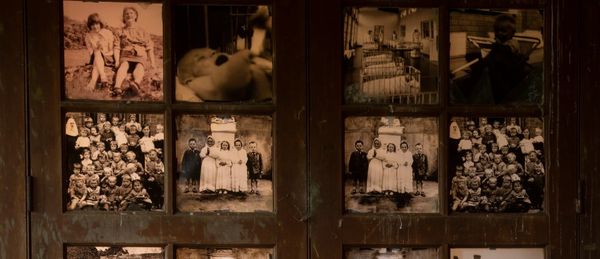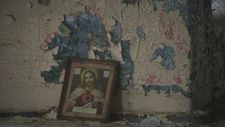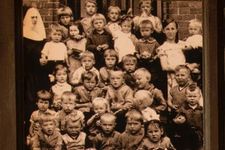 |
| Stolen |
In 1975, two boys in the small Irish town of Tuam discovered what turned out to be human remains in a playground. The authorities wrote it off as an old burial ground from the time of the famine. 37 years later, local historian Catherine Corless began an investigation into children born at the former Mother and Baby Home in the area, eventually uncovering so many discrepancies that she was able to persuade the police to investigate its grounds. What followed was the discovery of large numbers of children’s bodies, with 802 children believed to have died at the home during its 36 yeasrs of operation, many from causes which it is difficult not to associate with neglect. 12 women also died there – but that was just the tip of the iceberg.
The scandal with subsequently engulfed the island, with socking cases on both sides of the border, involves horrors which are difficult to countenance, not least because the practices from which they stemmed ended as recently as the 1990s. Margo Harkin’s powerful new documentary, Stolen, investigates what happened, with women who were resident in the homes telling their stories, and addresses the cultural issues which made it possible. It’s screening as part of Docs Ireland, and shortly before the festival began I spoke with Margo about the process of making it. It is, she says, still a contested subject.
“There was a series of vicious attacks on Catherine Corless at the time,” she explains. “Local people said it wasn't true, you know, what she says happened. And then these right wing evangelical groups in America targeted her online and a lot of posts started to appear where people said she's been discredited. A guy actually came on radio and more or less said the same thing. He must have been motivated by that group in America. And Catherine came on the radio and just completely challenged him on everything he said. It's good to have an opportunity to talk about all of the homes and all the things that went on.”
 |
| Stolen |
She can’t actually cover all of them in this documentary, she notes, because there are just too many, so she only covered a selection. It is a subject with enormous scope. I ask her how she began narrowing it down and figuring out what to include.
“That has been the hardest thing to do,” she says. “All we could do was pick a representative group of people that this experience has happened to. We looked to spread it around the country and we concentrated on three or four big ones, like Tuam and Sean Ross Abbey, and Roscrea in Tipperary and Bessborough in Cork because lots of children died – more died there than died in Tuam. Just looking for people who had been there, it can be quite hard to find people but once you find somebody then they tell you about somebody else.
“We wanted to make sure we had somebody from the North, and then we got two people from the North – one who was sent by nuns in the North from this training school for girls. She was sent to St. Patrick's mother and baby home down in Dublin – it doesn't exist anymore. So like it was a cross border example as well. And then we did Adele Johnson in Newry. So we just gradually put that together. But you know, we've left so much out. I mean, there are thousands of people that this happened to. The problem for me was trying to get it to a reasonable length. It's very long and not everybody's going to want to watch that length of a film. But I couldn't find it in my heart to cut anybody.
“It took a long time, much longer than I expected it to take, but I was determined that we would try and get as much as we could get in, and also capture a few issues like the vaccine trials. Some of the survivors’ groups were very disappointed that other documentaries haven’t covered them because there's been a series of documentaries and there's never going to be enough. They haven't even excavated the bodies yet from Tuam, for example, so it remains to be seen what happens there. And nobody knows where the babies are at Sean Ross Abbey. The local people believe that they're buried somewhere on the grounds, so they want excavations done there as well. So far the government has only committed to an excavation at Tuam.
“It was hard, because normally I don't do that kind of film. I like to go on a journey. Covid affected the shape of the programme, because I couldn't do that. The most important thing to me was to get the statements, to try and get people where they're still alive, because they're dying, and many have died.”
She had no difficulty persuading people to talk about it, she says.
“People were very, very keen to get the story out. Somethings that often happens with people who have been traumatised is that they get used to telling a version of their story and they don't much like to deviate from that. They didn't like me to interrupt them, and I had to explain that it was taking an hour or more to tell me that story and we've got to kind of pick and choose, you know? But they're very keen. They've done a lot of press interviews so they were really pleased that this was happening. And when they saw it they were really pleased as well. They felt it had been a respectful take on what had happened, that they had been treated respectfully, because they haven't been for so much of the time. They’ve been treated very badly.”
I remark that it must have been emotionally exhausting to make the film. After watching it, I found myself sitting and screaming silently for a bit because it made me so angry. How did she get through it?
 |
| Stolen |
“Well, you know, you’re on it for a very long time so you get used to doing it. Of course you're affected, and you have a lot of empathy for the people, but you're working, and so you're trying to find the best way to tell the story. So I don't really have time to get overly emotional. I just, I mean, like you, it’s probably more rage. I have a lot of anger about this happening to people, but I was just chatting and chatting and channelling that into focus to get the stories down. There was a lot to do and I just had to get on with it. I can't say that I was so messed up in my head that I couldn't do it. I never felt that. I always felt that I’d got to tell this story.”
The use of poetry and art adds another layer to the film. How did she choose which works to include?
“Right? That was a device to try and make the story easier to tell, to break it up. Because you know, it’s quite relentless. And I also became very aware that there was a huge response among women, especially, to what was happening, and it was expressed in many ways. I mean, there have been all sorts of art forms involved in responding to what happened, but poetry seem to be the one that could evoke the deepest feelings about what was happening, like Annemarie Ní Churreáin’s poem Six Ways To Wash Your Hands – the first time I heard her telling it was at a poetry reading in Derry and the hair stood up on the back of my neck. I just thought ‘Wow!’ She is such a brilliant poet. And just the language that poets manage to bring to the subject, it's very different from the factual telling of it. It just adds another emotional resonance to the whole thing.
“Again, one thing trips off another. I read an article which referenced the work of Alison Lowry, and I had seen the exhibition of those glass christening gowns that she made, and so I went to see her, and she was living in Saintfield and doing amazing work. So she's the only visual artist, and then Caelainn Hogan, who was a journalist, her book [Republic Of Shame] became a great consultancy source. She was a consultant on the film, her art form was writing, and I wanted to have a little bit of her in it as well.
“I knew some of the poets. I've known them for years, like Sarah Clancy, whose work I admire so much, because I go a lot to Galway. I've been to poetry readings of hers. I love poetry. I just think it's another dimension in terms of expressing our human feelings. And Elaine Feeney’s work I knew as well, and they introduced me to Jessica Traynor. I was mostly just looking for ones that spoke to the subject of it. There’s one by Elaine Feeney where she talks about the love for this child, We used that after Terry Harrison's interview because Terry’s story was so sad, she never had a relationship with her son, her son doesn't want to know her. I just thought if we put that after her story, it can express the longing she had for this little baby that she never got to keep.”
We talks further about Michael, the film’s only male interviewee.
“It was such a sad story,” she says. “It’s kind of forgotten about, the whole story of children who were fostered out – from the age of six, like, and not knowing where they were going. And his story was so important as well because he grew up not knowing who he was. He was not allowed to trace his background. He didn't know his mother or father were, but as soon as he tried to join the army, they were able to do it. It seems extraordinary that you would have no agency over your own life and knowing how you came into the world, but I mean, his story was great because apart from the loss of his childhood, the fact that he got to meet his mother, as he said, just in time before she died, and it all worked out.
“It's just good to see a photograph in the film and know that he has such a sense of contentment now that he got to meet his mother and knows who he is, and that he has all these cousins! That's the other remarkable side of this – people do find out who they are. They've got all these relatives that they knew nothing about. So you don't really know how it's going to go as you're doing it, I mean, that's what documentary is like. You just explore and some of the threads you drop and others you pick up.”
 |
| Stolen |
Something which seems quite bold about the film is the way that it links the scandals to Ireland’s emerging nationhood – notwithstanding that the UK was also complicit, with one woman being forcibly sent back to Ireland after visiting a London hospital.
“That was horrific. I had no idea about that story,” she says. “Essentially, she said they kidnapped her. Well, it was a Catholic Church that did it, but yeah, the hospital let those people in to make their records and you know, she was reported. I think her aunt probably had some part in that; she thinks so too, but it was never admitted. But people were so enslaved to the Catholic church at the time. Yeah, that that was probably one of the most shocking stories and didn't have a happy outcome for her. It was really sad.
“I think it's very important to understand the context for why these things happened. Right from the start, both myself and my producer wanted to know, like, why did this happen? What was the social climate that caused this to happen? To what extent was Ireland a theocracy? You know, all of those questions. That's why Mairead Enright was so invaluable. My jaw was dropping with her insights, that when this new state was being created, it was trying to differentiate itself from what had been there before. And so they reverted to this notion of Irish women as being, well, I think English woman were conceived as being...” She hesitates, wanting to find a polite term. “Not as sexually pure as some Irish people would have liked,” she says, and we both laugh.
She reflects on the archive footage in the film which shows people at work drawing up the new Irish constitution.
“They were all men. Women had had very radical roles in the period before that, which I'm watching a lot of stuff about at the minute and reading stuff on. Women had an incredible radical role, and that was all lost. They wasted no opportunity in putting women back where they believed they belonged, back in the home. You weren't allowed to work. If you'd got a civil service job, or, you know, some kind of job at a university or any of those kinds of jobs that were controlled by the state to some extent – it was never the law, by the way, that women weren’t allowed to work – it was a guideline that was perceived to be the way it should be. I found out some really interesting things, and hopefully those parts aren’t boring.”
I assure her that they’re not. Of course, one of the most shocking things about all this is that it went on into the 1990s, but we do get a look at the next generation towards the end of the film, and things really seem to be changing for the better now. Does she feel positive about that?
“Absolutely,” she says. “But the thing is, you can never say, you know, we won’t go back. because that always surprises you, doesn’t it? But I think, you know, we never thought we would get abortion rights in Ireland, and yet that whole wave of young people, men and women – it’s not just women, but woman have been great agitators, demanding change and fighting, fighting, fighting. And it's so uplifting. I mean, we’re still fighting in the North to get healthcare for women properly established, but yeah, I just think that generation is not willing to put up with that kind of slavish attitude to religion that we were all brought up with.
“My generation was brainwashed. I mean, we did resist too, but I still have friends whose whose children go to religious schools, because it's so deeply embedded in Irish society. I actually asked, ‘Why do you do this?’ And it's because you can't get into the good schools unless you're taking your kid to have first communion or confirmation. That all has to change. The whole island, North and South, needs to become secular. I mean, we're much more secular in the North, but never forget that although this was happening en masse in the Republic of Ireland among Catholic orders, it was also happening in the north, almost the same extent, among Protestant faiths as well.
“In the North, slightly more than half of them were a Catholic and the rest were Salvation Army, Church of Ireland, Presbyterian churches. They were all suppressing women and judging them. It seems outrageous now. And it took actual practical things, it wasn't that people's mental attitude changed overnight. Once they got the Single Parent’s Allowance, that gave them a little bit of economic freedom, because a lot of it's tied on economics as well. A woman didn't have economic power because she wasn't allowed to work and earn money. She just had to abide by what the social mores were.”
Unfortunately, the official report on what happened has left a lot of people dissatisfied.
“The people who really, really believed and hoped that they would get something good out of this have been so angry about it. It’s so, so sad, and would take me too long to go into the detail of how they abused the trust and privilege that these women gave to them. I mean, this is the big question: is it a secular state or not? It needs to become absolutely secularised. But it’s so embedded in the South, you know. You go anywhere – churches, hospitals – you know that recent row about the Mater Hospital. It all points to the fact that they still have a lot of power. It is waning though. Definitely waning. And someday they won't be there. So I do have hope for the younger generation, I really do. We’re not putting up with this shit anymore.”





















